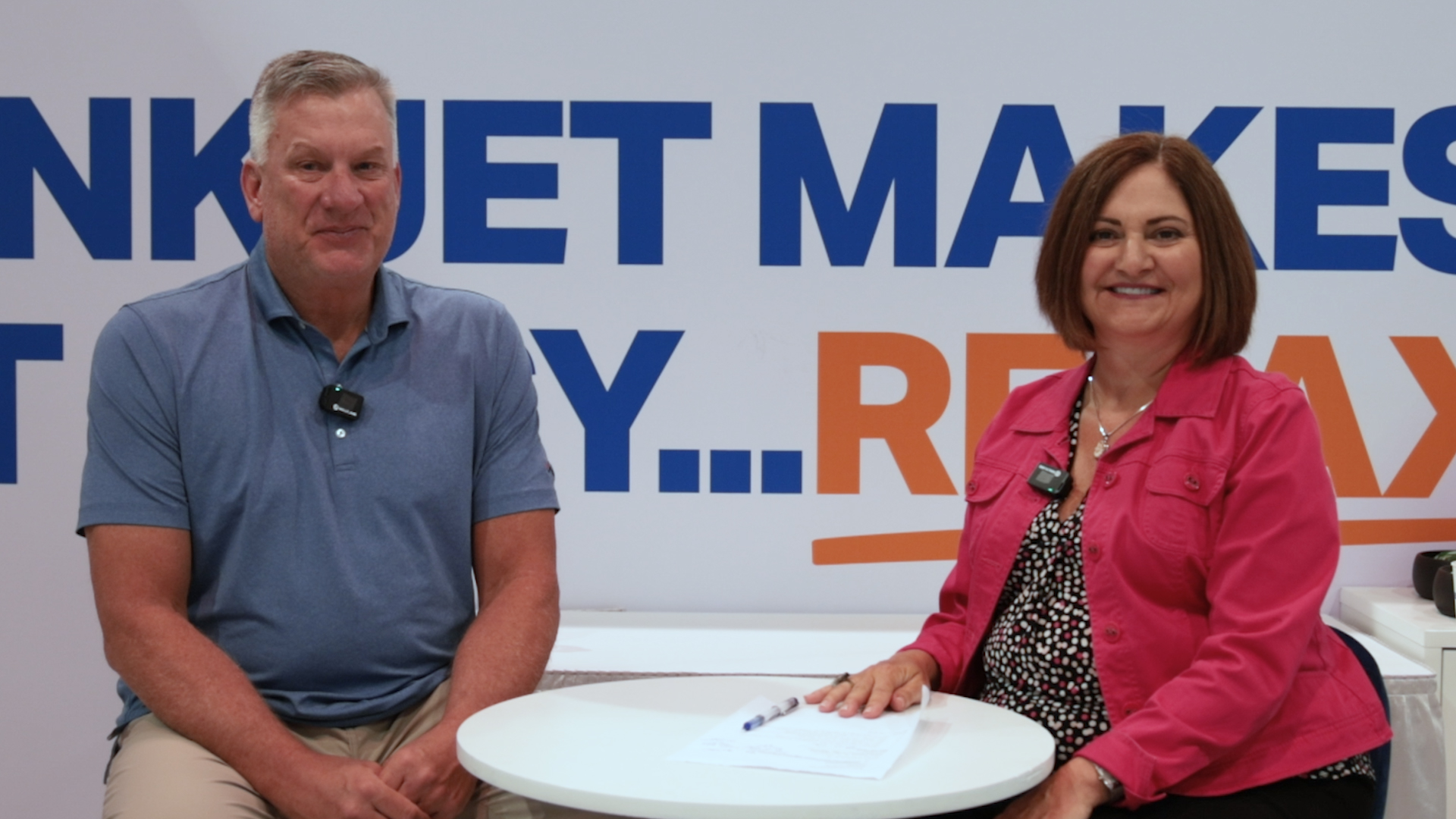Frank Has a Point
Frank rants about the small print. He attributes the problem to poor knowledge about typographic x-height. The number used to express point size does not truly describe the actual size of the type being printed.
 Official camera partner of WhatTheyThink and the drupa daily. Video from drupa 2024
Official camera partner of WhatTheyThink and the drupa daily. Video from drupa 2024
Video Center
- Questions to ask about inkjet for corrugated packaging
- Can Chinese OEMs challenge Western manufacturers?
- The #1 Question When Selling Inkjet
- Integrator perspective on Konica Minolta printheads
- Surfing the Waves of Inkjet
- Kyocera Nixka talks inkjet integration trends
- B2B Customer Tours
- Keeping Inkjet Tickled Pink
© 2024 WhatTheyThink. All Rights Reserved.















Discussion
By Joe Treacy on Oct 27, 2023
Frank, you’re exactly right. And as you mention, the problem is not only pharmaceutical products, but it’s rampant across non-regulated or mildly regulated health & fitness packaging and labeling as well as consumer packaging.
The Nutrition Facts and Supplementation Facts panels and their Other Information and related info do have mandated point size minimums.
But abiding by a government-mandated minimum point-size or inch-height measurement (as some specs are) does not mean you’re doing the right thing for your customers.
Go outside the Facts panel to Directions for Use and seemingly all bets are off. Suddenly, photos and iconography are featured larger than crucial text like Directions for Use and Baking and Cooking Times.
Hence, it’s very easy to over-bake something if you’ve only glanced at the instructions. In some fonts at tiny sizes, 6 or 9 can look like 8, 4 might look like 9 at a glance, and do on.
I’ve been a typographic consultant to a Supplements company for 17 years, and believe me, I’ve seen this happen with packaging layouts over and over.
And I’ve had to step in and advise both the designers, quality control staff and management that they need to “remember their customer”…as we echo in type design… “remember the reader”.
In fact, where I have the opportunity to specify what type families are used both inside and outside the Facts panels, I will always select types that are both “large on the body” within their imaginary em-square height, AND which have a large x-height. (Mostly, modern designs that take a note from the Linotype Legibility Series and what it does in serif form for surviving newsprint printing.
But parameters to consider don’t stop there.
The numbers must be both the right size highly recognizable. Numbers whose terminals don’t close up on themselves are more legible in tiny sizes. (Despite that Helvetica medium is in the Facts Panel specs, it’s often not the best choice and other font families can readily be used.)
Today’s packaging designers often don’t realize that most Google Fonts often have oddball numbers and other characters like the ampersand, that should disqualify them from Facts panels and Directions for Use copy.
Punctuation must be properly designed. Italic is often used for latin chemical names and so the font families’ italics must be appropriately designed.
For extremely small use cases like “Stick Packets” that for example contain powdered drink mixes to add water to, the bold types used for phrases like “Nutrition Facts” must “hold open” both in their interior counter shapes and also between the letters.
If the font selection does not, even on digital presses like the Indigo running with high resolution, the bold weight characters can still slur together and challenge legibility.
It’s really the fault of the packaging designers and production people not stopping to actually stare at what they’ve just laid out in type, and asking themselves, “Can my target customer actually read this?”
As you mention, especially as packaging is downsized and the overall population continues to skew older, the answer increasingly is “No.”, and yet they proceed anyway.
I believe the additional contributing problem is large monitors. As I’ve watched company management (who often fancy themselves as design savvy) review packaging onscreen in PDF at an enlarged size, readability doesn’t seem to be a problem.
But they forget the actual printing size, the inked resolution (especially in flexo and offset) and things just get approved that shouldn’t. And once it gets approved, that instantly gets replicated across the product line. Then, it can be 5-10 years before the staff feels like readdressing the legibility.
As you know when I started Treacyfaces.com, my focus was (and is) solely on high-legibility faces through a combination of large on the body, tall x-height and appropriate letterspacing and kerning.
It’s amazing for me to see how faces like my TFForever increase readability dramatically. And it works automagically, with no fussing needed.
I’m happy to consult with any graphic arts company or manufacturer who has determined they need packaging legibility help.
Frank, I appreciate your focus on this subject which has vast and increasing global implications, and not only in the US and North America. It needs much more exposure to the design community. Perhaps repeated as an article in WhatTheyTh!nk, with close-up visuals highlighting the problem.
By Joe Treacy on Nov 01, 2023
Frank, I’d like to add one more observation to help understand how to fix legibility/readability problems in packaging.
Again, it appears to happen because of designing on large monitors, and then not viewing high-resolution, actual size press proofs.
Typeface (font) selections that are simply too light in addition to being too small create a frustrating reading environment that can sometimes hide valuable cooking instructions right in plain sight.
And btw, this isn’t only true on printed packaging. Very often, that same “too light” font selection is then also picked up and used on the customer’s accompanying product website page or landing page.
Equally hard to read onscreen, because too-light text is also often not just slightly set tight, but sometimes very tightly typeset, creating a glaring kind of appearance that resembles more of an impenetrable geometric crazy quilt, rather than an easily readable paragraph or copy block.
Too-light font weights can include names like Thin, Extralight and Light. If you as part of production see that, consider suggesting to the designer to bump up the text weight to Regular or even a Book weight.
You could describe a too-light weight “nearly unprintable” or “borderline” or something like that. Because it can be: Sometimes it can be one antialiased row of pixels or dots describing letters in tiny text. And more than one or two rows of pixels or dots is typically needed to properly smooth small-set letterforms in text.
To correct that, the designer should go for 9 to 12 point if possible. Especially if they’re not using a large x-height font. It’s so important to packsging success that nearby images and iconography should be shrunk in order to present important text properly.
So, first: making sure the point size is readable. Then, if you also see vitally important text set too light, suggest a Regular or Book weight.
Being sure that your imaging resolution settings are set to their highest will produce more resolved text that helps readability. (It’s been my experience as a designer working with printers that sometimes even digital press imaging resolution settings have to be mentioned to even the most experienced staff. It simply happens, and today is so easily corrected.
In fact, a printer could turn looking after imaging resolution into a specific competitive selling point.
While attending to these nuances might seem foreign to staff, once acclimated, these are all quick fixes. And they not only produce instantly more readable text, but (even on digital presses today) more printable text.
Readers across the customer’s entire target audience will silently thank you by simply being more successful at cooking or baking the product, creating greater user satisfaction.
And if you as production and printer have developed a great working relationship with the packaging designer, I’ll bet they’d (perhaps silently) thank you.
I know that I would. Let’s face it: it’s all about helping to guarantee complete customer satisfaction from the designer, to the pressroom and all the way to creating a very happy consumer who becomes a repeat buyer.
Discussion
Only verified members can comment.